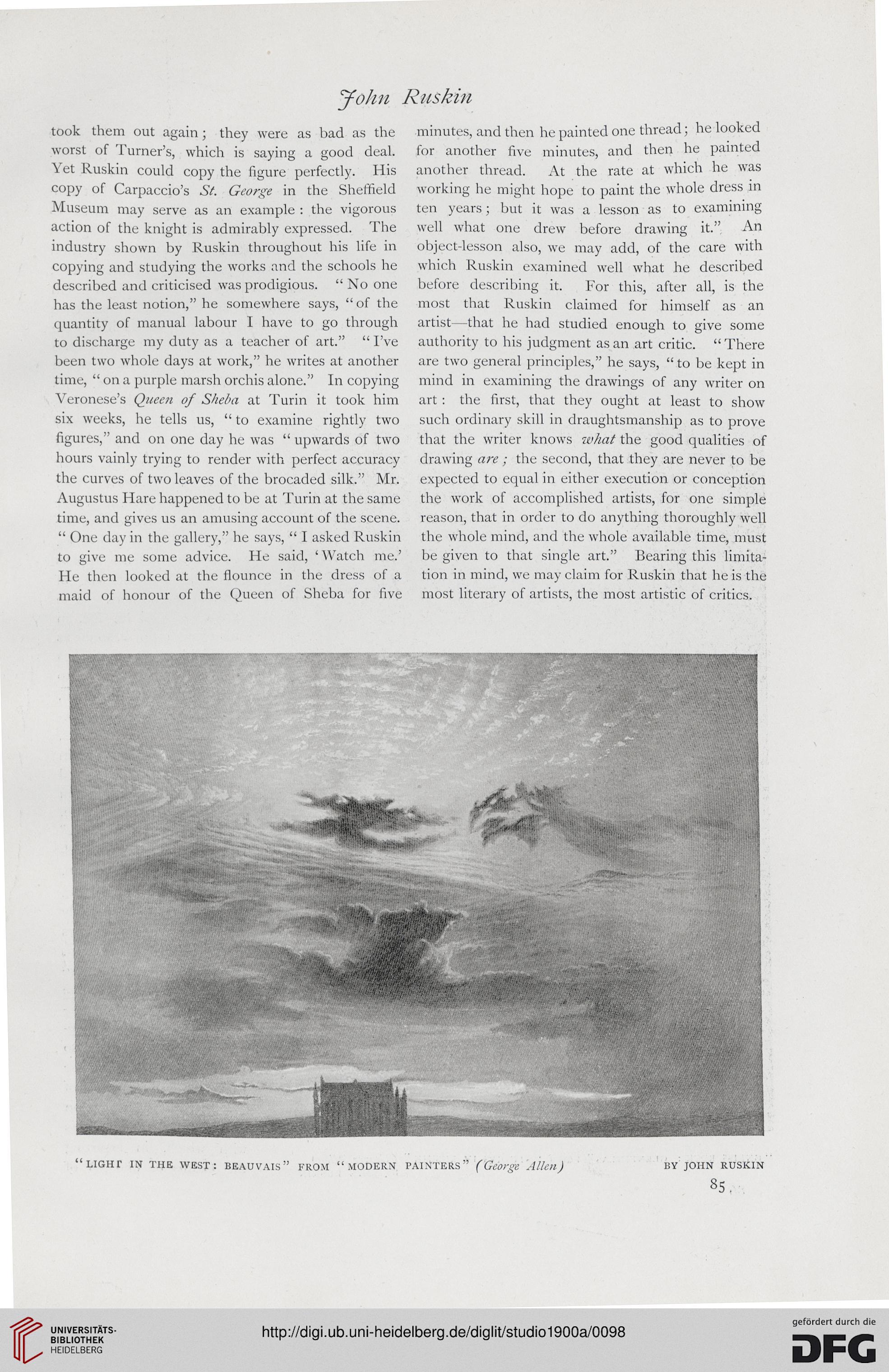John
took them out again ; they were as bad as the
worst of Turner's, which is saying a good deal.
Yet Ruskin could copy the figure perfectly. His
copy of Carpaccio's St. George in the Sheffield
Museum may serve as an example : the vigorous
action of the knight is admirably expressed. The
industry shown by Ruskin throughout his life in
copying and studying the works and the schools he
described and criticised was prodigious. " No one
has the least notion," he somewhere says, "of the
quantity of manual labour 1 have to go through
to discharge my duty as a teacher of art." " I've
been two whole days at work," he writes at another
time, " on a purple marsh orchis alone." In copying
Veronese's Queen of Sheba at Turin it took him
six weeks, he tells us, " to examine rightly two
figures," and on one day he was " upwards of two
hours vainly trying to render with perfect accuracy
the curves of two leaves of the brocaded silk." Mr.
Augustus Hare happened to be at Turin at the same
time, and gives us an amusing account of the scene.
" One day in the gallery," he says, " I asked Ruskin
to give me some advice. He said, ' Watch me.'
He then looked at the flounce in the dress of a
maid of honour of the Queen of Sheba for five
Ruskin
minutes, and then he painted one thread; he looked
for another five minutes, and then he painted
another thread. At the rate at which he was
working lie might hope to paint the whole dress in
ten years; but it was a lesson as to examining
well what one drew before drawing it." An
object-lesson also, we may add, of the care with
which Ruskin examined well what he described
before describing it. For this, after all, is the
most that Ruskin claimed for himself as an
artist—that he had studied enough to give some
authority to his judgment as an art critic. "There
are two general principles," he says, "to be kept in
mind in examining the drawings of any writer on
art : the first, that they ought at least to show
such ordinary skill in draughtsmanship as to prove
that the writer knows what the good qualities of
drawing are ; the second, that they are never to be
expected to equal in either execution or conception
the work of accomplished artists, for one simple
reason, that in order to do anything thoroughly well
the whole mind, and the whole available time, must
be given to that single art." Bearing this limita-
tion in mind, we may claim for Ruskin that he is the
most literary of artists, the most artistic of critics.
took them out again ; they were as bad as the
worst of Turner's, which is saying a good deal.
Yet Ruskin could copy the figure perfectly. His
copy of Carpaccio's St. George in the Sheffield
Museum may serve as an example : the vigorous
action of the knight is admirably expressed. The
industry shown by Ruskin throughout his life in
copying and studying the works and the schools he
described and criticised was prodigious. " No one
has the least notion," he somewhere says, "of the
quantity of manual labour 1 have to go through
to discharge my duty as a teacher of art." " I've
been two whole days at work," he writes at another
time, " on a purple marsh orchis alone." In copying
Veronese's Queen of Sheba at Turin it took him
six weeks, he tells us, " to examine rightly two
figures," and on one day he was " upwards of two
hours vainly trying to render with perfect accuracy
the curves of two leaves of the brocaded silk." Mr.
Augustus Hare happened to be at Turin at the same
time, and gives us an amusing account of the scene.
" One day in the gallery," he says, " I asked Ruskin
to give me some advice. He said, ' Watch me.'
He then looked at the flounce in the dress of a
maid of honour of the Queen of Sheba for five
Ruskin
minutes, and then he painted one thread; he looked
for another five minutes, and then he painted
another thread. At the rate at which he was
working lie might hope to paint the whole dress in
ten years; but it was a lesson as to examining
well what one drew before drawing it." An
object-lesson also, we may add, of the care with
which Ruskin examined well what he described
before describing it. For this, after all, is the
most that Ruskin claimed for himself as an
artist—that he had studied enough to give some
authority to his judgment as an art critic. "There
are two general principles," he says, "to be kept in
mind in examining the drawings of any writer on
art : the first, that they ought at least to show
such ordinary skill in draughtsmanship as to prove
that the writer knows what the good qualities of
drawing are ; the second, that they are never to be
expected to equal in either execution or conception
the work of accomplished artists, for one simple
reason, that in order to do anything thoroughly well
the whole mind, and the whole available time, must
be given to that single art." Bearing this limita-
tion in mind, we may claim for Ruskin that he is the
most literary of artists, the most artistic of critics.




